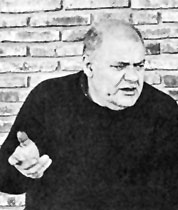
He was born in Minturno, Italy, in 1920. In 1935, he began his painting studies in Rome with the painter Antonucci. He worked as a decorator and restorer of churches. In 1939, during World War II, he was called up and he served on the North African front. For three years he was interned in a French prisoner-of-war camp. At the end of the war, in 1947, he participated in the Prima Esposizione dello Sindicato Provinciale delle Arte Figurative, in the Venice Palace in Rome.
He arrived in Buenos Aires in 1950 as the guest of a friend, who lectured at the Universidad Nacional de Tucumán. As a man, he had been formed in Europe, but as an artist he matured in Argentina. That same year, he exhibited figurative paintings of expressionist style at Galería Renoir in Rosario. In 1955, he joined the Asociación Arte Nuevo. After briefly practicing constructive abstraction, he defined himself as a sculptor in 1957. In 1958, he took part in Panorama de la escultura no figurativa en la Argentina (Panorama of non-figurative sculpture in Argentina) exhibition.
Sculpture was, for Paparella, "a sort of adventure and encounter" that allowed him to work directly in three dimensions, without having to draw on the representational resources of painting, creating a more direct language with which to communicate his concern about the situation of modern man.
From his first works in stone and wood where he explores gentle organic volumes up to the dazzling white Monumentos inútiles (Useless Monuments) of the seventies, passing through the iron assemblies, the beaten aluminium or the boxes and objects made from waste materials, Paparella developed a work of deep existential commitment.
This is exemplified in his series of Sugerencias (Suggestions), begun at the end of the ‘50s, where iron and aluminium display the textural accidents of the material, establishing his work on the lines of informalist sculpture. In the beaten aluminium pieces, the sheet is hammered, folded and rent, to create spectral images which, lacerated by the hand of the artist, reveal the traces of his gestures and bear witness to his very existence.
In the mid ‘60s, he produced a rigorously geometric series. The works made of anodised aluminium were constructions of great size entitled Asépticos en progresividad (Aseptic on progression) and were related to minimalism.
Paparella predominantly sought poetry as the only means of rescuing the human race from consumerist alienation. However, this poetry is not expressed through an evasive language but shows “the ruins” and the erosion of modern man, destroyed by a materialism that alienates him from his inner self. This is the meaning of the Useless Monuments developed between 1971 and 1976, and made of such fragile materials as wood, cardboard, plastered fabrics, impeccably whitened with chalk and glue.
Through his objects and constructions, he tried to reveal a magical and mysterious world since, as he said, he worked "... in search of the occult which after all is poetry".
He carried out his last solo sculpture exhibition in September 1976, under the title Un cuarto de retrospectiva. (A quarter of a retrospective). He died in Buenos Aires in 1977.